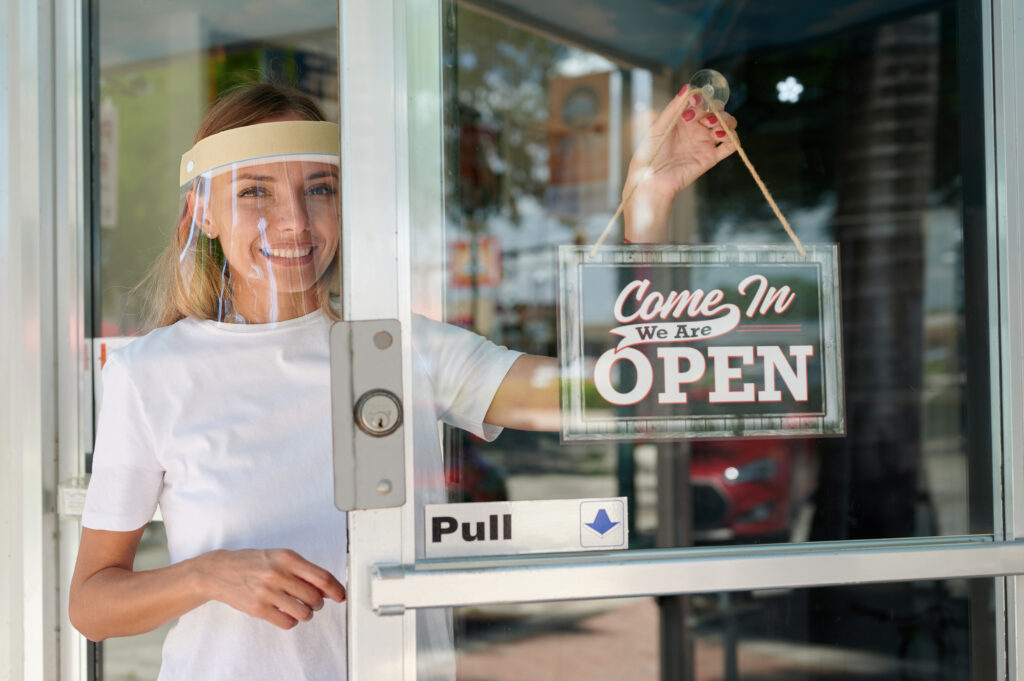Face shields may not just be for healthcare workers anymore. While they’ve become a common sight in the offices of doctors, dentists and other medical professionals, face shields can provide added protection and other benefits that may be ideal for teachers, service industry workers and even the general public.

Face Shields Enter the Spotlight
In a recent interview with ABC, Dr. Anthony Fauci brought eye protection into the national spotlight. “If you have goggles or an eye shield, you should use it,” said Fauci, adding, “if you really want to be complete, you should probably use it if you can.”
Dr. Deborah Birx, the White House coronavirus response coordinator, agrees. Shortly after Fauci’s interview, she told “Fox & Friends,” “The thing about the face shields — we think that that could protect the individuals and that it would decrease the ability for them to touch their eyes and spread [the] virus as well as those droplets coming towards them.”
Many medical experts even believe that face shields offer superior protection to masks for preventing viral infection.
When asked if a face shield or similar eye covering will be required, Fauci responded, “You know, it might.” However, most experts agree that ensuring that medical professionals have an adequate supply of face shields is priority, noting that a face mask is a lot easier to make at home than a face shield.
One place where face shields are required? Qatar Airlines, which started requiring a face shield in addition to a face mask in July.
So how can face shields provide added protection, and why might this PPE be ideal for teachers and other interaction-based professionals?
How Face Shields Offer Added Protection Against COVID-19
COVID-19 is known to spread when infected droplets come into contact with the eyes, nose or mouth. This can happen either via particles in the air (often from a cough or sneeze), or if someone’s contaminated hands rub their eyes.
Unlike face masks alone, face shields provide protection for all three of these entry points. So what does the science say? A recent study in The Lancet journal shows that eye protection is associated with lower COVID-19 infection rates.
According to an earlier JAMA report, face shields significantly reduce the amount of inhalation exposure to the influenza virus, which is a droplet-spread respiratory virus like COVID-19. A simulation study showed that face shields reduced viral exposure by 96% when worn by a simulated healthcare worker standing within 18 inches of a cough.
Notably, the CDC recommends that healthcare workers wear a face shield or similar eye protection in addition to a face mask and other appropriate PPE.
Benefits of Face Shields Beyond Eye Protection
In addition to providing a barrier against droplets, face shields offer comfort, convenience and improved communication, all of which make this added protection ideal for teachers and other service workers.
- Comfort and Wearability: Unlike more restrictive PPE, like a face mask or goggles, a face shield can provide comfort and easy wearability for extended periods of time, which is ideal for all-day wear.
- Simple to Wear Properly: We’ve all seen questionable use of face masks, which are often improperly worn below the nose, partially covering the mouth, or simply pulled down below the chin. Face shields, on the other hand, are easy to wear properly and without much fuss.
- Prevents Face Touching: Popular studies show that we touch our faces anywhere from 16 to 23 times per hour. Unfortunately, face masks can exacerbate this habit, as they are frequently adjusted, and taking them on and off often requires touching your face. Not only do face shields remind you not to touch your face, they provide a physical barrier that makes it impossible.
- Better Communication: When appropriate social distancing can be maintained, whether in a classroom setting, behind a plastic barrier, or across another type of physical barrier such as a check-in desk or even a bar, the use of a face shield without a face mask could greatly enhance communication.
Face masks can make it difficult to speak with another person because the volume of your voice is slightly muffled, and it’s impossible to read lips — or infer meaning from an expression. This can make it especially difficult for educators to effectively instruct their students. With a face shield, students may be more inclined to listen to (and understand) the instruction.
As we know, regulations and recommendations continue to change by the minute. Will eye coverings become mandatory at some point? Will teachers and service professionals in need of PPE widely adopt face shields? While the future remains to be seen, the fact remains: face shields can offer added protection against coronavirus.
For the best effectiveness, be sure to look for a face shield that provides a tight seal on your forehead and extends below your chin and around your cheeks.
